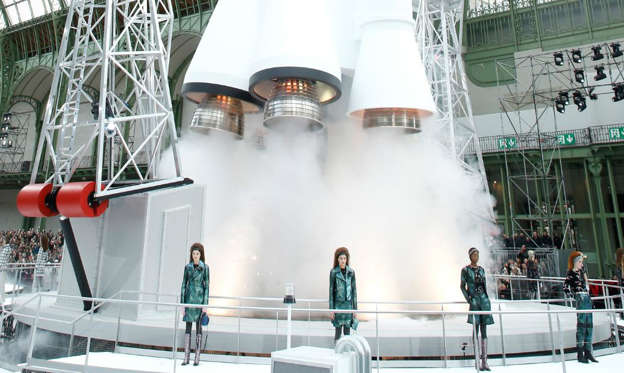A Visual History Of Space-age Fashion

© Kurita Kaku/Gamma-Rapho/Getty Images A prepared specialist, André Courrèges utilized his numerical ability when building pieces of clothing.
The 1960s space race was a significant proportion of logical advancement. The expectation of this next phase of humankind had a permanent effect on culture, as well. President John F. Kennedy’s vision of man arriving at the moon before long generated a crowd of TV shows and movies – including animation sitcom “The Jetsons” and in this manner the “Star Trek” establishment – all of which hoped to oblige America’s freshly discovered revenue in spaceflight.
The accomplishment of the Apollo 11 mission in 1969 just whetted fits of hunger further. For style architects Paco Rabanne, Pierre Cardin, and Thierry Mugler, it turned into the rocket that dispatched a thousand looks, as they revolved entire assortments around an intergalactic vision of the more drawn out term.
Regardless of whether it had been a junk mail shift dress, a bulbous protective cap, or a couple of obvious white boots, the fashion tradition of the ’60s and ’70s was characterized by a space-race richness. Be that as it may, even a long time after we originally set foot on the moon, the universe has stayed a backbone of motivation for a spread of style houses.

© Toni Anne Barson Archive/WireImage/Getty Images John Galliano took his bow while wearing a Dior high style spacesuit in 2006.
Presently as a substitution space race unfurls, this point with an individual’s central goal to Mars not too far off, we take a look back at style’s suffering sentiment with space, during which craftsmanship mimics living things – regardless of whether outsider or space traveler – and divine bodies the same.
Pierre Cardin
The early work of Italian architect Pierre Cardin, imagined here at Paris Fashion Week in 1968, was a course of silver vinyl. Cardin, who kicked the bucket in December 2020, was a pioneer of room age design, creating sharp, innovator outlines from shining lamé texture. His cutting edge plans are worn by any semblance of ’60s style symbol Mia Farrow and consequently the Beatles.
André Courrèges
André Courrèges delivered his Moon Girl assortment, including white go-go boots and tall, circular caps, inside the spring of 1964. The late originator utilized high-sparkle PVC to develop hardened A-line skirts that held their own when bent and bent in design shoots. His advantage in intergalactic excitement just developed from that point. After thirty years, Courrèges was all the while sending space-roused peers down the runway, as envisioned here at an April 1993 show in Kyoto, Japan.

© Vittorio Zunino Celotto/Getty Images Iris van Herpen’s high design show in 2019 was filled with extraterrestrial-looking manifestations.
Paco Rabanne
For some architects, the space race implied experimentation. Spanish planner Paco Rabanne was the same, molding small shift dresses and coordinating with headgear out of odd materials like ring mail. Rabanne’s presently infamous junk mail manifestations caused his models to show up as though extraterrestrial champions – wearing body reinforcement that was a balance of sixteenth-century knight and advanced artist.
Reed Crawford
Cap crossovers were key highlights of the ’60s space-age style. At a London cap show in 1966, the late British fashioner Reed Crawford appeared the “Dollar Princess” cap, a half-visor, half-space-head protector creation that looked particularly advanced – despite being comprised of silver milk bottle tops.
Thierry Mugler
At Paris Fashion Week 1986, the Fall-Winter assortment by French mark Thierry Mugler was overflowing with decorated star themes and elaborate ear sleeves that stood up like radio wires. Quite a bit of Mugler’s assortments all through the ’80s included space-age ladies wearing large, square-shaped shoulder braces covered in gold or silver lamé.
Givenchy
Yet, not every person felt hopeful about our quick move toward the future. Alexander McQueen’s 1999-2000 Fall-Winter assortment for Givenchy was packed with “interest, and dread, of the more drawn out term,” together Vogue runway audit from 1999 put it. Models were studded with jutting metal fittings, and neon lights emanated off of white PVC as their whole bodies became circuit sheets.

© Keystone/Hulton Archive/Getty Images Pierre Cardin helped lead the space-age stylish with a variety of groups in silver vinyl.
Dior
After Dior’s 2006-2007 Fall-Winter high style show at Paris Fashion Week, the name’s innovative chief at that point, British fashioner John Galliano, wore a space traveler suit as he did a standard lap around the catwalk.

© Pierre Vauthey/Sygma/Getty Images Givenchy’s Fall-Winter 1999-2000 assortment addressed a specific tension about the thousand years. Moschino
At Milan Fashion Week in 2018, Moschino’s Fall-Winter arrangement returned us to the space-age ’60s in a substitute manner. Models wore desserts concealed mod dresses with high neck regions and pillbox covers à la Jackie Kennedy Onassis, in the interim wearing powerful-looking green, blue, or yellow skin – a signal to flowing apprehension motivating thoughts that the late first lady had been a mysterious pariah.
Reed Crawford showed the “Dollar Princess” cap at a style show made by the accomplice people from the Incorporated Society of London Fashion Designers. Two or three individuals that are staying during a room: Thierry Mugler embraced a more ethereal technique to bombastic style and made female outfits fit an area princess.

© Daniel Simon/Gamma-Rapho/Getty Images Thierry Mugler embraced a more ethereal technique to cosmic style and made cultured outfits fit an area princess.
For the Chanel Fall-Winter, 2017-2018 arranged to-wear collection, the Grand Palais in Paris housed a gigantic monogrammed rocket transport that even went through a fake dispatch, all out with flooding smoke. Models stayed before the rocket wearing “Jetsons”- inspired outfits with shimmer knee-high go-go boots and twofold breasted bouclé skirt suits.
Commes des Garçons
Around a similar time, Rei Kawakubo’s combination for Commes des Garçons was sculpturally space-age. More hypothetical than A-line, the expanded pieces of clothing worn by Kawakubo’s models were included silver insurance material and seemed like coasting pieces of room refuse.
Iris van Herpen
No maker working today appears all the more dependably influenced by heavenly shapes and thoughts than Iris van Herpen. The stage plan for her 2019 variety Hypnosis incorporated a round figure by American skilled worker Anthony Howe that drag a striking similarity to the lunar stages. consistent with the show saw, the Dutch fashioner was spurred by cosmic subjects of “boundless expansion” and “a broad life cycle.”
Balmain
Today, space really gets the imaginative psyche of style. For the Balmain Fall-Winter 2021-2022 collection that showed up at the current year’s Paris Fashion Week, the catwalk transformed into a record of an escape. A rocket overhang, a plane, and shockingly the moon floated intriguingly behind strutting models as watchers fantasized as one about going during a pandemic. No goal was inconceivable, even off-world.

At Paris Fashion Week Womenswear in 2017, Chanel wowed audiences with a branded rocket. © Bertrand Rindoff Petroff/French Select/Getty Images

